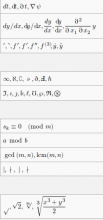Client side MathJax rendering is outdated. There are browser plugins that support MathJax rendering for chrome. The advantage with those plugins is that they use the most recent actively maintained version of MathJax and do not require that users log in.
See also

